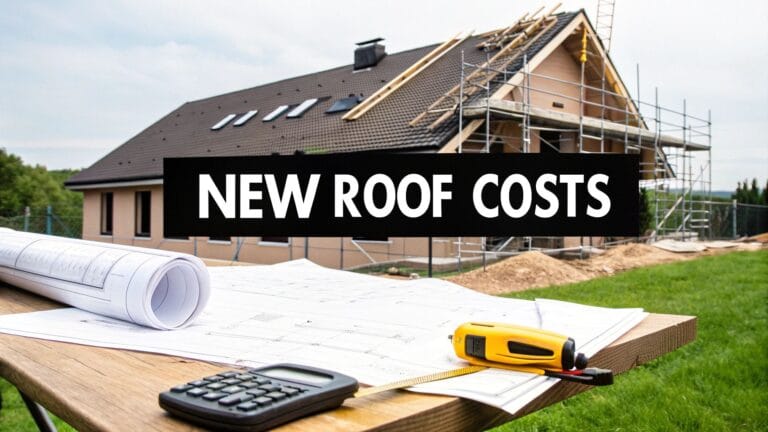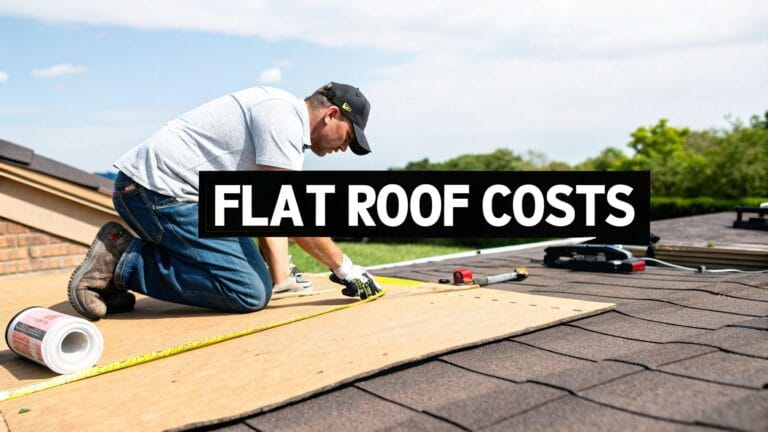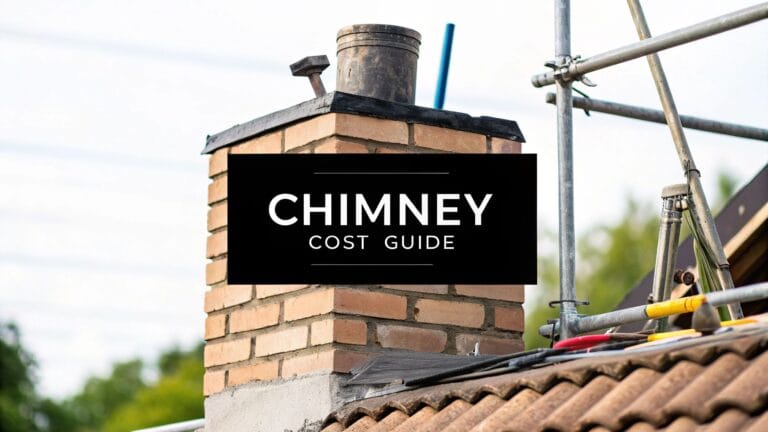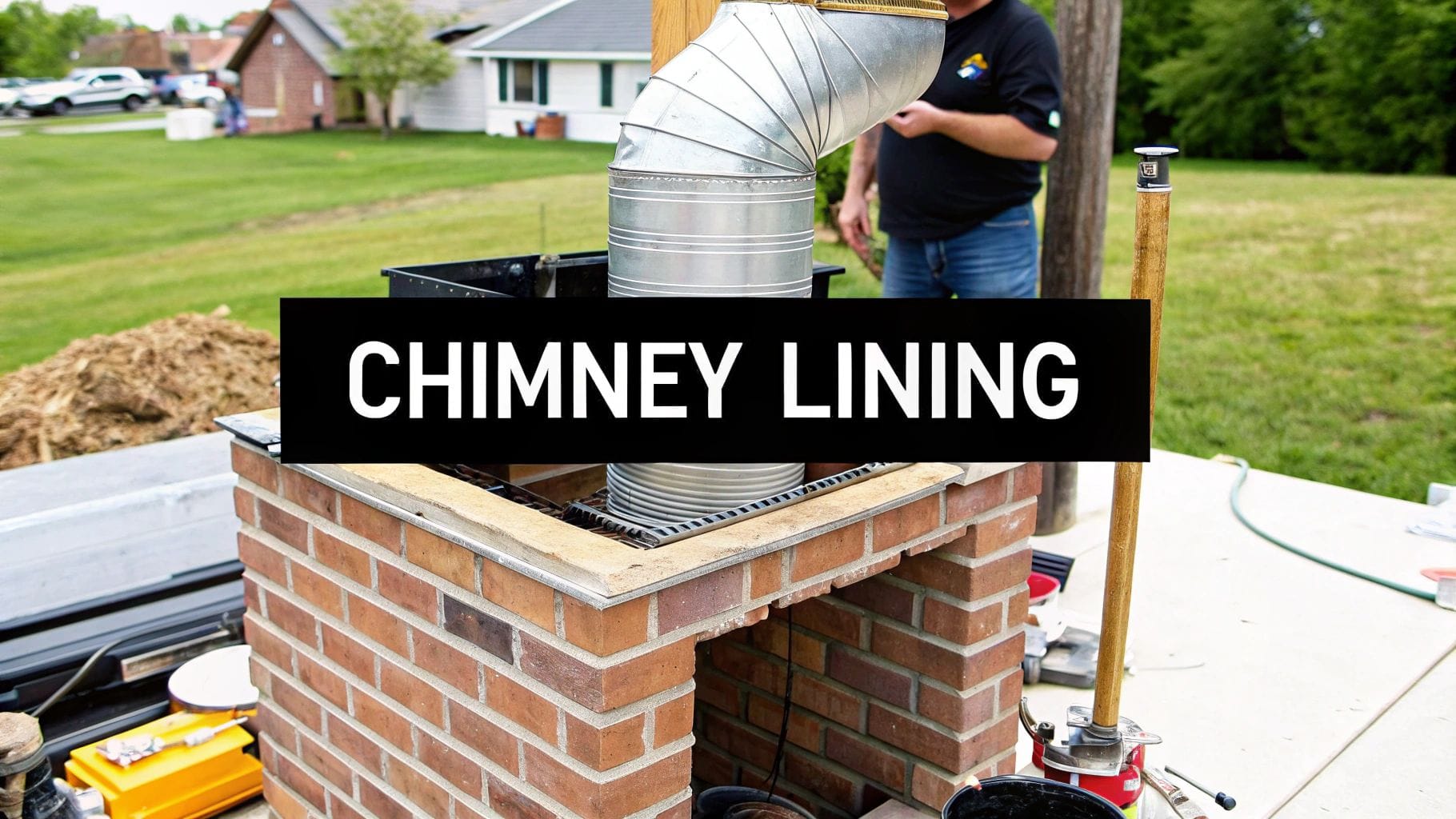
UK Guide to Chimney Lining Installers
Find expert chimney lining installers in the UK. Our guide covers costs, materials, and how to hire a certified pro for your home's safety and efficiency.
When it comes to your fireplace or stove, the chimney liner is arguably the most crucial safety component. Think of it as the essential barrier standing between the intense heat of your fire and the structure of your home. That's why hiring professional chimney lining installers isn't just a good idea—it’s absolutely vital for safety, efficiency, and meeting UK regulations. A proper installation from our certified team at Evershield Roofing is what guarantees your appliance works as it should, giving you complete peace of mind.
Why Your Home Needs a Professional Chimney Liner

Imagine a chimney flue without a liner. It’s like trying to contain a roaring fire with just a single, uninsulated pipe—a disaster waiting to happen. A professionally installed chimney liner is the unsung hero of your heating system, a purpose-built channel that works tirelessly to protect your home and your family.
Investing in a proper installation is a direct investment in your property's value and, more importantly, in your family's safety. Without one, you're leaving yourself open to serious risks that are so easily avoided.
The Core Pillars of Chimney Liner Safety
A professionally installed liner tackles three key safety issues that an old, unlined, or damaged chimney simply can't handle. There's a good reason these functions are legal requirements under UK Building Regulations.
- Heat Protection: First and foremost, a liner stops the intense heat from your fire from reaching combustible materials within your home's structure, like timber joists or roof trusses. This massively reduces the risk of a house fire.
- Gas Containment: It creates a sealed, gas-tight tube that safely funnels dangerous combustion by-products, especially deadly carbon monoxide, up the flue and out of your home. Older brick chimneys often have crumbling mortar joints, which can allow these toxic gases to seep into your living areas.
- Improved Efficiency: A correctly sized liner is key to maintaining the temperature of the flue gases. This improves the 'draw' or draught of the chimney, helping your fire or stove burn more efficiently, which means you'll use less fuel and see less build-up of soot and creosote.
An unlined or badly lined chimney isn't just inefficient; it's a recognised fire hazard. A professional installation from Evershield Roofing ensures every part of the system, from the liner itself to the cowl on top, works in harmony to create a completely sealed and safe passage from your appliance to the rooftop.
Of course, the integrity of the chimney stack itself is just as important. A liner can only do its job if the surrounding brickwork is structurally sound. For more on this, you can learn about our dedicated chimney repair services. At Evershield Roofing, our certified installers make sure your entire system is safe, compliant, and installed with the expertise needed for a secure and effective solution.
Choosing the Right Chimney Liner Material
Picking the right chimney liner isn't just a technical detail; it’s a crucial decision for the safety and performance of your fireplace or stove. Think of it like choosing the right engine oil for your car—using the wrong type can cause serious, expensive damage. The material you select has to be perfectly matched to your fuel and chimney, ensuring everything works as it should for years to come.
For example, a liner designed for a modern gas fire simply can't cope with the intense heat and corrosive by-products of a solid fuel stove. Our expert installers at Evershield Roofing will assess your whole setup—whether you're burning wood, smokeless fuel, gas, or oil—and guide you to the right material. This is especially important in older UK homes, where unique chimney dimensions and structural quirks often call for a specialist solution.

As the image shows, getting the measurements spot-on is a non-negotiable part of the job. Our professional installers take precise readings to guarantee the liner fits perfectly. This meticulous approach is key to ensuring your new liner functions safely and efficiently inside your existing chimney.
Common Liner Materials and Their Uses
Here in the UK, we primarily work with three main types of chimney liners. Each has its own strengths, and knowing the basics will help you have a much clearer conversation with your installer about what's best for your home.
- Stainless Steel Flexible Liners: These are by far the most popular choice for relining existing chimneys, particularly in older properties where the flue isn't perfectly straight. They come in two main grades: 316 grade for wood burners and most smokeless fuels, and the more robust 904 grade, which is a must if you plan on burning more corrosive fuels like coal.
- Pumice Liners: Formed from volcanic rock, pumice is a fantastic natural insulator and incredibly durable. You'll often see these used in new builds or as part of a major chimney rebuild. A pumice liner is a long-term investment that really lasts.
- Ceramic and Clay Liners: These are the traditional workhorses of the industry. They offer brilliant resistance to high temperatures and corrosion. However, because they are rigid sections, they are only suitable for straight, newly constructed chimneys.
It's not just about the liner material, though. Insulation plays a massive role. Wrapping the liner in insulation keeps the flue gases hot, which helps improve the chimney's draw and, crucially, reduces the build-up of flammable tar and creosote. In many cases, insulation isn't just a good idea—it's a requirement for safety and compliance.
Chimney Liner Material Comparison
To help you visualise the options, we've put together a simple comparison of the most common materials we install. This table breaks down what each material is best suited for, along with its key benefits and potential drawbacks.
| Liner Material | Best For | Pros | Cons |
|---|---|---|---|
| Stainless Steel (316/904) | Relining existing chimneys, especially those with bends. | Flexible, versatile, and cost-effective installation. | Shorter lifespan than rigid systems; 904 grade is essential for corrosive fuels. |
| Pumice | New builds or complete chimney rebuilds. | Excellent insulation, extremely durable, and very long lifespan. | More expensive and requires a full rebuild; not suitable for relining. |
| Clay / Ceramic | Straight, newly built chimneys. | Exceptional heat resistance and longevity. | Rigid sections cannot navigate bends; installation is more labour-intensive. |
Ultimately, the best choice depends entirely on your specific chimney and appliance. A quick chat with an Evershield Roofing professional can help clarify which route is the safest and most effective for you.
A Practical Look at Costs
Naturally, the material you choose will have a direct impact on the overall cost of the installation. In the UK, prices can vary quite a bit depending on the liner type and the height and complexity of your chimney.
As a general guide, stainless steel flexible liners typically range from £450 to £700 for a standard installation, thanks to their versatility. More traditional clay liners might cost between £750 and £1,000. For top-tier performance, premium pumice or ceramic liners, known for their superior heat resistance and longevity, could range from £850 to £1,500 or more. You can explore more detailed pricing information to get a better sense of all the factors involved.
Understanding Chimney Liner Installation Costs
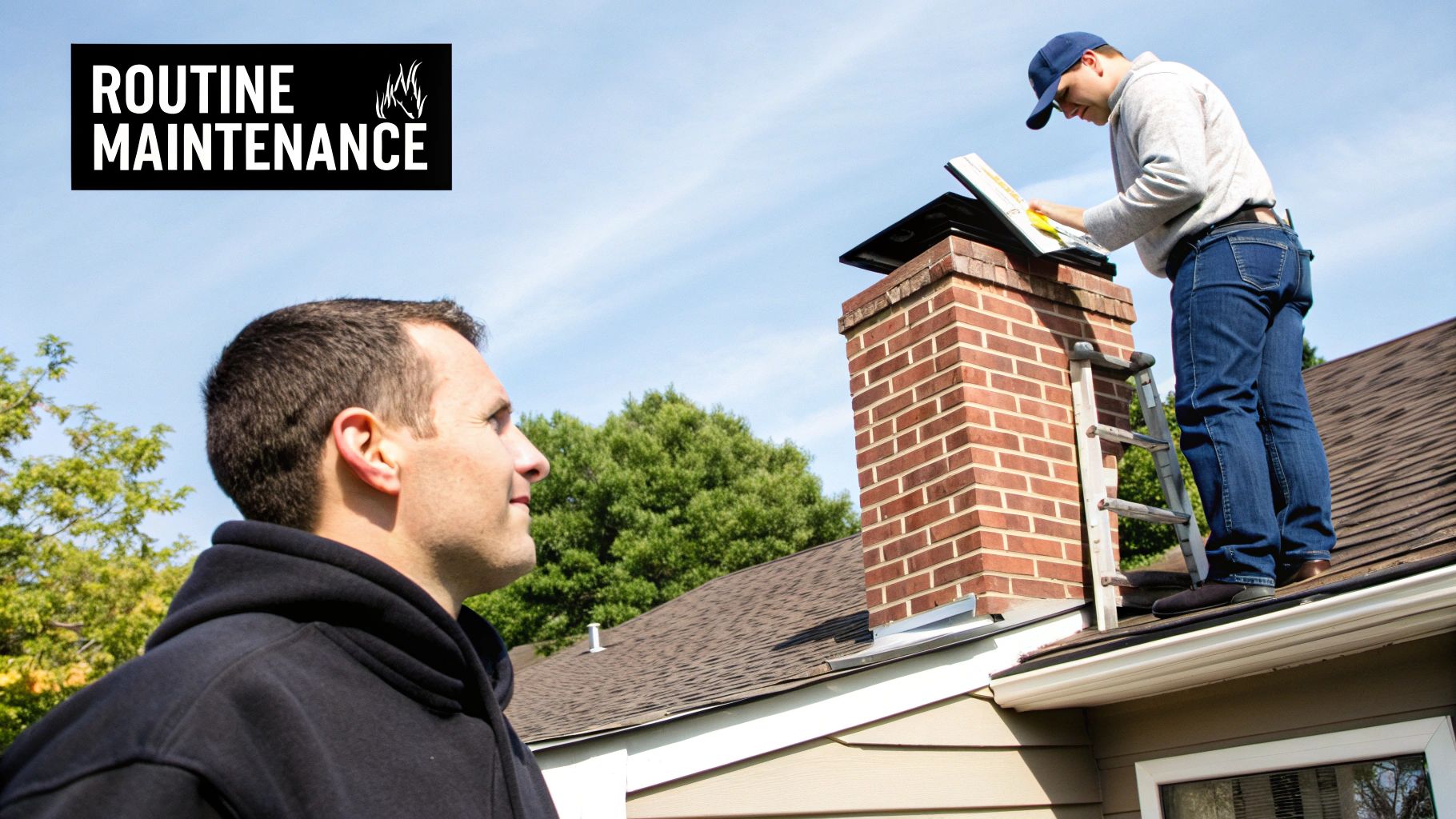
When you're looking at the cost of a new chimney liner, it's easy to focus on the price tag of the liner itself. But in reality, you're not just buying a product off the shelf; you're investing in a comprehensive professional service. The final figure on any quote is influenced by several important factors, and getting to grips with them will help you understand exactly what you're paying for.
At Evershield Roofing, we pride ourselves on being completely upfront about costs. Our itemised quotes are designed to be crystal clear, breaking down every part of the job so you know precisely where your money is going. No jargon, no hidden extras. We believe this transparency is key to building trust and showing you why a proper, professional installation is an investment in your home's safety and long-term performance.
Key Factors That Influence Your Quote
Any quote you get from reputable chimney lining installers will be a blend of materials and expert labour. Here’s a look at the main components that shape the final cost:
- Labour Costs: This is usually the biggest part of the bill. It's not just about the time spent physically fitting the liner. This cost covers a full safety inspection, a thorough chimney sweep, and the careful work of sealing and commissioning the entire system so it works perfectly.
- Chimney Height and Access: It’s simple, really: a taller chimney needs a longer liner, which costs more. The job also takes longer. If your chimney is particularly hard to get to, we might need to put up scaffolding to work safely, which will be factored into the price.
- Removal of an Old Liner: If there’s an old, failing liner in your chimney, it has to come out before the new one goes in. This can be a tricky and time-consuming job, especially if we're dealing with old concrete or clay sectional liners that have crumbled.
- Making Good: Installing a liner can sometimes cause a bit of disruption to the plasterwork around your fireplace opening. A professional quote from us will always include the cost of "making good"—that is, re-plastering and tidying up the area to leave it looking neat and finished.
Your final quote is a direct reflection of the work required to do the job safely and correctly. A suspiciously cheap quote often means corners are being cut, potentially on vital safety checks, the quality of the liner, or the inclusion of necessary insulation.
Breaking Down Labour Charges
The cost of skilled labour is a significant part of any installation. Here in the UK, professional chimney lining installers typically charge a day rate of between £180 and £250, which works out at an hourly rate of about £22 to £32.
Most installations take between one and three days from start to finish, depending on how complex the job is. For a deeper dive into pricing, you can find more information about the factors that influence chimney liner installation pricing on Checkatrade.com.
Finding and Vetting Your Installer
Choosing the right person to install your chimney liner is every bit as important as picking the right material. It’s simple, really: you can buy the most advanced, expensive liner on the market, but if it's installed badly, it’s not just ineffective—it can be downright dangerous. A great installer, like our team at Evershield Roofing, knows how to make every part of the system work together, giving you complete peace of mind.
Finding genuinely skilled chimney lining installers is about more than just a quick search online. You need to look for specific credentials that prove they understand and adhere to UK safety standards. This is your single best guarantee that the job will be done properly from the start.
Look for HETAS or OFTEC Registration
In the UK, there are two key accreditations that act as a gold standard for anyone working with heating appliances. Think of them less as a badge and more as your assurance that the installer has undergone rigorous training and is regularly checked to ensure their work is up to scratch. At Evershield Roofing, our team is fully registered and compliant.
- HETAS (Heating Equipment Testing and Approval Scheme): This is the one you need to know about for solid fuel systems like wood-burners and multi-fuel stoves. A HETAS registered professional can self-certify their installations. This is a huge benefit, as it means they can officially confirm the work meets Building Regulations, saving you the hassle and cost of getting a separate inspection from your local council.
- OFTEC (Oil Firing Technical Association): If your home is heated by an oil-fired appliance, you'll need an OFTEC registered technician. Just like HETAS, this registration proves their expertise and allows them to sign off their own work as fully compliant.
Choosing a HETAS or OFTEC registered installer is the most straightforward path to a safe, legal, and compliant chimney system. It should be the absolute minimum requirement you look for.
Essential Questions to Ask Your Installer
Once you have a shortlist of potential installers, it’s time to dig a little deeper. A true professional will be happy to answer your questions and will provide clear, straightforward information. The process isn't so different from vetting any other tradesperson for your home. We cover similar ground in our guide on choosing the right contractor for your new roof.
Here’s a quick checklist of what you should be asking:
- Are you HETAS or OFTEC registered? Don't just take their word for it. Ask for their registration number so you can check it on the official HETAS or OFTEC websites.
- Can you provide proof of public liability insurance? This is a deal-breaker. It protects both you and your property if something goes wrong. Evershield Roofing is fully insured for your peace of mind.
- Will I receive a Certificate of Compliance? This is the formal document that proves the work meets Building Regulations. You'll need it for your home insurance and if you ever decide to sell your house. We provide this with every certified installation.
- Do you provide a written, itemised quote? A professional will always lay out the costs clearly, detailing everything from materials and labour to any extras like scaffolding. Our quotes are always transparent and itemised.
- What warranty do you offer on the liner and your workmanship? Make sure you understand exactly what’s covered and for how long.
Navigating UK Chimney Regulations
Let's talk about regulations. It's easy to see them as just red tape, but when it comes to chimneys and flues, these rules are genuinely life-saving. They’re the blueprint for keeping your home and family safe from fire and fumes. Any good chimney lining installer will tell you their work is built on these standards, and understanding the basics helps you see why professional expertise is so crucial.
A proper, compliant installation isn't just about ticking boxes. It's fundamental to your home insurance, your family's safety, and even the future sale of your property. We don't just follow the rules; we make sure you understand why they matter so much.
Translating Document J into Plain English
The bible for our trade is Approved Document J. This hefty document lays out the legal requirements for everything from wood burners to fuel storage systems here in England. It might look intimidating, but its core principles are all about common-sense safety. Our job is to translate those technical standards into a safe, reliable installation in your home.
So, what does Document J actually cover? Here are a few key areas:
- Hearth Requirements: The hearth is the fire-resistant patch in front of your appliance. Its size and thickness aren't random; they're specified to shield your floor from intense heat and any stray embers that might escape.
- Ventilation: Fires need oxygen to breathe, just like we do. Document J dictates how much fresh air your specific appliance needs to burn cleanly and prevent a dangerous build-up of poisonous gases like carbon monoxide.
- Flue Outlets: Where the smoke comes out matters. The regulations are very specific about the height and position of your chimney pot or terminal to make sure fumes disperse safely into the atmosphere, well away from windows, neighbours, or flammable roof coverings.
A compliant installation isn't an optional extra; it's the heart of the job. Getting it right ensures your stove or fire is safe, efficient, and properly signed off. It’s the only way to protect your investment and get complete peace of mind.
The Non-Negotiable Safety Measures
Beyond the structural bits and pieces, Document J is crystal clear on essential safety devices. For any new solid fuel appliance, installing a carbon monoxide (CO) alarm isn't just a good idea—it's the law. This small device is your frontline defence against a gas you can't see, smell, or taste.
When you bring in our expert chimney lining installers, you're getting more than just a new flue. You're hiring a team that lives and breathes compliance. We sweat the small stuff, making sure every hearth is measured correctly, every flue has the right airflow, and a life-saving CO alarm is fitted and tested before we’d ever call a job finished.
The Installation Process: A Practical Walkthrough
So, you’ve decided to get a new chimney liner installed with Evershield Roofing. What actually happens on the day? It can feel a bit daunting having tradespeople working in your home, so we want to walk you through exactly what our team does, from the moment we pull up to the final safety check. No jargon, no surprises.
First things first, we treat your home like our own. Before any tools come out, we lay down dust sheets and take every possible step to keep your living space clean and tidy. It’s a simple thing, but it’s important to us.
Site Survey and Flue Preparation
Before we can even think about fitting the new liner, we have to get the chimney ready. This isn't just a quick peek up the flue; it's a critical preparation phase that sets the stage for a safe and successful installation.
- A Proper Sweep: We start with a thorough chimney sweep. We're talking about clearing out everything – soot, creosote, fallen debris, maybe even an old bird's nest or two. This gives us a clean, unobstructed path to work with.
- The Smoke Test: Next, we perform a smoke test. Think of this as a pressure test for your chimney. By filling the flue with smoke, we can spot any hidden cracks or leaks in the chimney stack. Finding these now is crucial, as they could otherwise let dangerous fumes seep into your house.
Skipping this stage is simply not an option. It’s all about ensuring the new liner goes in smoothly and that the chimney itself is structurally sound.
It's good to know you're making a wise investment. With more homeowners focusing on safety, the UK market for flue and chimney products is growing, and some firms have seen revenue jump by over 10%. You can see more on current UK chimney industry trends if you're interested in the data.
The Core Installation Phase
With the chimney prepped and ready, the main event begins.
Our certified installers work as a team, carefully guiding the new, insulated stainless steel liner down the chimney from the roof. This takes a delicate touch and good communication to ensure it doesn't get snagged or damaged on the way down.
Once it's in position, we make the crucial connections. At the bottom, we securely attach the liner to the stove pipe. At the top, we fit a new pot-hanging cowl and clamp, which holds the liner in place and protects it from rain and birds.
Finally, we get to the most important part: safety. We install a brand-new carbon monoxide alarm – this is a legal requirement and an absolute must-have. Then, we commission the appliance by lighting a small, controlled fire. This lets us check the draught and make sure the whole system is drawing smoke up and out exactly as it should. We won't pack up until we’ve confirmed everything is working perfectly, and you’re completely happy.
Frequently Asked Questions
Over the years, our chimney lining installers get asked the same set of questions time and time again. Here are the answers to some of the most common queries from UK homeowners, helping you get to grips with what your chimney really needs.
Do I Need a Liner for a Wood Burning Stove?
Yes, in nearly every case. It’s not just a good idea; it's a requirement. UK Building Regulations (specifically, Document J) mandate a suitable flue and liner for any new solid fuel appliance. A liner is crucial for safety, but it also helps your stove run more efficiently by keeping the flue gases warm and creating a better draught. As a bonus, it makes the annual sweep much simpler.
How Long Does a Stainless Steel Liner Last?
The lifespan comes down to one thing: the grade of steel you choose. A 316-grade liner is the standard for wood burners and typically comes with a 10-15 year warranty. If you plan on burning more corrosive fuels like coal, you’ll need to step up to a 904-grade liner, which can easily last 25 years or more with the right care.
Remember, a warranty isn't a guarantee of lifespan. How you use and maintain your liner is what truly counts. Skipping your annual sweep or burning the wrong type of fuel will drastically shorten its life, no matter how good the steel is.
What Are Signs My Old Liner Needs Replacing?
Your chimney will often give you clues when the liner is failing. You might notice bits of debris or old clay tile fragments falling into your fireplace. Another common sign is a poor draught, which causes smoke to billow back into the room instead of going up the flue.
Look out for visible cracks in the chimney's brickwork or damp patches and tar stains appearing on the chimney breast walls. While these are strong indicators, only a professional CCTV inspection can give you a definitive answer. Regular upkeep is vital for the whole structure, and you can learn more about why you need to maintain your roof and its related components in our guide.
If you suspect your chimney needs attention, don't leave it to chance. For a professional inspection and a no-obligation quote from certified chimney lining installers, contact Evershield Roofing today. Our experts will make sure your chimney is safe, efficient, and fully compliant. Get in touch at https://www.evershieldroofing.co.uk.

